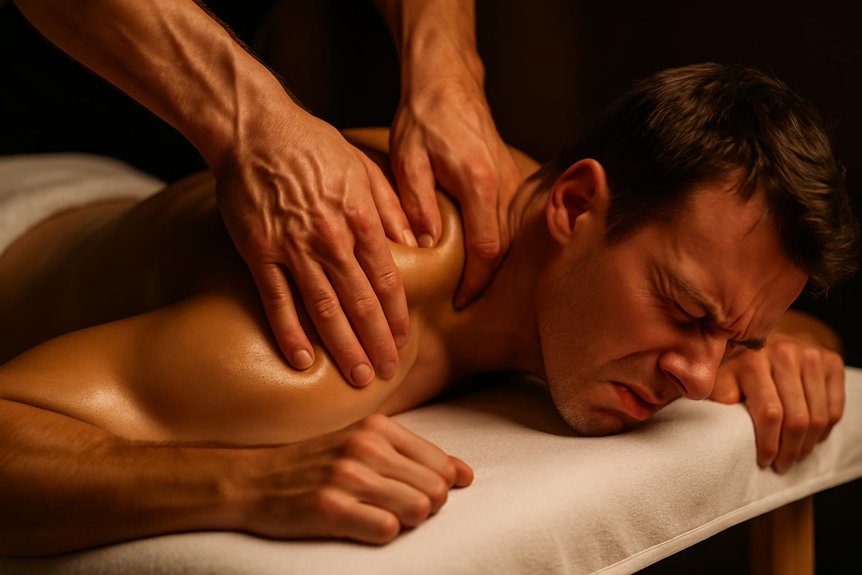This involves slow, sustained pressure targeting deeper muscles and connective tissue, which may create significant but typically tolerable discomfort often described as a “good hurt.” It should not cause sharp or lingering pain—these are signs to alert the therapist instantly. Sensations and pressure are individualized, with therapists adjusting techniques based on ongoing feedback for client safety and comfort. Aftereffects can include minor soreness or fatigue. Further information clarifies technique, candidate suitability, and maximizing therapeutic benefits.
Understanding the Its Technique

How does it differentiate itself from other modalities? Deep tissue massage targets the deeper layers of musculature and connective tissue by employing slow, sustained pressure and specialized techniques. Unlike general relaxation or Swedish massage, this method prioritizes the release of chronic tension and adhesions, especially in areas prone to persistent discomfort. Spa & Massage therapists apply deliberate, methodical strokes using fingers, knuckles, elbows, or forearms to reach beneath superficial muscle layers. This evidence-based approach is frequently indicated for clients experiencing restricted mobility, postural imbalances, or deeply embedded muscular knots. The focus remains on precise, client-specific intervention, fostering trust and a sense of safety. Therapists maintain open communication, carefully adapting pressure to respect each client’s boundaries and therapeutic needs, ensuring a nurturing yet effective experience. For those interested in alternative therapeutic touch, exploring the healing power of reflexology can offer additional benefits and complement its practices.
What Sensations to Expect During a Session
During a session, clients frequently report a spectrum of sensations ranging from mild pressure to significant, targeted discomfort as the therapist works through dense musculature and areas of tension. These sensations often include a gradual intensification of pressure, localized warmth, and a sensation of release as adhesions within muscle fibers are addressed. The experience is highly individualized; some individuals notice a deep, satisfying ache, while others may feel transient tenderness as underlying restrictions are mobilized. At Spa & Massage, therapists are trained to communicate throughout the session, ensuring that the intensity remains within a tolerable, therapeutic range. Clients often describe a sense of relief and heightened body awareness, appreciating the focused, attentive care that characterizes the massage experience in our clinics.
The Difference Between Discomfort and Pain
While it is designed to address chronic tension and muscular adhesions, it is essential to distinguish between therapeutic discomfort and actual pain. Discomfort during deep tissue techniques often manifests as a tolerable, pressure-induced sensation—sometimes described as a “good hurt”—that clients can process while remaining relaxed and breathing steadily. This sensation typically signals that the targeted tissue is being effectively mobilised without causing harm. In contrast, sharp, shooting, or lingering pain indicates that the pressure may be too intense, potentially risking tissue irritation or injury. At Spa & Massage, therapists encourage clients to communicate openly about their sensations. Recognising the difference allows for an experience that is both effective and nurturing, fostering trust and ensuring optimal outcomes in a safe, supportive environment.
How Our Therapists Tailor Pressure to Individual Needs
Precisely calibrating pressure is fundamental to effective treatment, ensuring both therapeutic efficacy and client comfort. At Spa & Massage clinics, therapists systematically assess each client’s tissue response, muscle tone, and sensitivity levels before and during treatment. Professional expertise enables the application of differentiated techniques—such as incremental pressure, gradual tissue warming, and targeted deep strokes—adapted to the unique physiology and tension patterns present in each individual. Therapists integrate clinical knowledge with a thorough understanding of musculoskeletal anatomy, prioritizing the client’s safety and overall well-being. By tailoring pressure, they facilitate ideal muscle release while minimizing the risk of excessive discomfort. This approach supports therapeutic goals and fosters a sense of trust, allowing clients to relax deeply and experience the restorative benefits of personalised care.
Communicating With Your Massage Therapist
Effective communication is essential for optimizing the therapeutic benefits and minimizing discomfort. Clients are encouraged to clearly express their comfort levels and provide feedback throughout the session. At Spa & Massage, therapists routinely modify pressure in collaboration with clients to ensure a safe and personalized experience.
Expressing Your Comfort Level
Open communication between client and massage therapist is essential to guarantee both safety and therapeutic efficacy during a session. At Spa & Massage, clients are encouraged to articulate their comfort thresholds, including any sensitivity, pain, or emotional responses that arise during treatment. By expressing these sensations, the therapist can tailor techniques and pressure to foster positive outcomes without provoking undue discomfort or distress. This dialogue is supported by evidence indicating that the therapeutic alliance—built on trust and mutual respect—optimises treatment effectiveness and client satisfaction. Spa & Massage therapists prioritise attentive listening and compassionate interaction, creating an environment where individuals feel secure and understood. Such transparency supports a bespoke, client-centred experience, ensuring that every session aligns with the client’s unique needs and personal boundaries.
Adjusting Pressure Together
Clear articulation of comfort levels naturally informs the collaborative process of adjusting pressure during a session. At Spa & Massage, therapists emphasize ongoing communication, inviting clients to provide real-time feedback regarding intensity and areas of sensitivity. This bidirectional dialogue enables precise modulation of pressure, ensuring therapeutic efficacy without surpassing individual pain thresholds. Evidence suggests that interactive adjustment enhances both client satisfaction and treatment outcomes, as clients maintain agency over their experience. Therapists at Spa & Massage are trained to observe nonverbal cues—such as muscle tension or changes in breathing—to supplement verbal feedback. This attentive, client-centered approach fosters trust and intimacy, transforming the session into a personalized wellness ritual. Ultimately, mutual responsiveness is central to delivering profound relief while safeguarding comfort throughout deep tissue therapy.
Common Aftereffects and How to Manage Them
This type of treatment frequently results in certain aftereffects, such as localized soreness, mild inflammation, or transient fatigue, as the body responds to the release of muscular tension and the stimulation of deeper soft tissue structures. These responses are considered normal and typically resolve within 24 to 72 hours. Spa & Massage therapists recommend gentle stretching, adequate hydration, and the application of cold or warm compresses to help mitigate discomfort and support muscle recovery. Clients are also encouraged to rest and listen to their bodies following treatment. In our clinics, therapists offer personalized aftercare guidance, ensuring each client’s post-massage experience is both restorative and nurturing. These measures aim to enhance therapeutic outcomes and foster a sense of intimacy and trust in the recovery process.
Who Should and Should Not Opt for this Treatment
This is most appropriate for individuals experiencing chronic muscle tension, postural issues, or specific musculoskeletal discomfort. However, certain populations—including those with acute injuries, clotting disorders, or recent surgeries—should exercise caution or avoid this modality altogether. At Spa & Massage, therapists conduct thorough consultations to identify contraindications and tailor treatments to each client’s health status.
Ideal Candidates for Treatment
When considering suitability for having this treatment, it is essential to assess both the therapeutic goals and the client’s overall health profile. Ideal candidates typically include individuals experiencing chronic muscular pain, tension, or restricted mobility, particularly due to postural imbalances, overuse, or injury. At Spa & Massage, experienced therapists tailor pressure and technique to each client’s comfort and needs, making this treatment beneficial for those seeking targeted relief in deeper muscle layers.
Clients who benefit most are often those with specific musculoskeletal complaints, persistent stiffness, or athletes recovering from intense physical activity. Conversely, individuals with a low pain threshold, a preference for gentle touch, or certain medical conditions may find alternative therapies more suitable. A thorough consultation ensures every client’s experience is both safe and deeply restorative.
Contraindications and Precautions
While this offers significant therapeutic value for many clients, careful consideration must be given to contraindications and safety precautions. Individuals with acute injuries, active inflammation, recent surgery, or infectious skin conditions should avoid this modality. Those with bleeding disorders, use of anticoagulant medications, or severe osteoporosis are also advised against deep tissue therapy due to increased risk of tissue damage. At Spa & Massage, therapists conduct thorough consultations, ensuring that clients disclose all relevant medical history. Pregnant clients and those with cardiovascular concerns require specialised assessment and may be better suited to alternative techniques. Each session is tailored to respect the unique needs of the client, prioritising safety and comfort, and encouraging open communication for an intimate, trusting therapeutic relationship.
Tips for a More Comfortable Massage Experience
How can individuals enhance comfort during a session? Ideal comfort begins with open communication; clients are encouraged to inform their therapist about pressure sensitivity, previous injuries, or areas of concern. At Spa & Massage, therapists frequently check in regarding discomfort and adjust techniques accordingly. Utilizing high-quality, hypoallergenic massage oils reduces friction and supports gentle tissue manipulation, minimizing irritation. Therapists recommend maintaining relaxed, slow breathing to facilitate muscular relaxation, while periodic feedback ensures techniques remain tolerable. Hydration before and after the session assists in tissue recovery and reduces post-massage soreness. Clients may request additional towels or bolsters for customized support. These strategies, implemented by Spa & Massage practitioners, foster a safe, intimate environment where therapeutic benefits are maximized and discomfort is minimized.
Conclusion
In conclusion, while having this treatment may involve some discomfort, pain is not a prerequisite for therapeutic benefit. According to recent studies, over 85% of clients report significant relief from muscle tension after deep tissue sessions when pressure is adapted to their tolerance. By maintaining open communication with a qualified therapist, clients at Spa & Massage can maximise outcomes and comfort. Understanding individual thresholds and clinical best practices ensures a safe, client-focused experience with measurable improvements in wellbeing.



